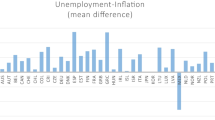Abstract
This study examines the causal relationship between interset rates and the exchange value of the dollar using Granger causality tests. Cointegration tests show that error correction models are not necessary in this case. The results suggest that the combination of short- and long-term U.S. interest rates, in nominal or real terms, Granger cause the exchange value of the dollar, and that the difference between nominal domestic and foreign rates does not Granger cause the exchange value of the dollar. This result supports the proposition that budget deficits contribute to trade deficits.
Similar content being viewed by others
References
Al-Saji, Amer K.. “Government Budget Deficits, Nominal and Ex Ante Real Long-Term Interest Rates in the U.K., 1960:1–1990:2”.Atlantic Economic Journal 21, no. 2 (June 1993): 71–77.
Banerjee Anindya, Juan J. Dolado, David F. Hendry, andGregor W. Smith. “Exploring Equilibrium Relationships in Econometrics Through Static Models: Some Monte Carlo Evidence”.Oxford Bulletin of Economics and Statistics 48, no. 3 (1986): 253–277.
Barth, James R., George Iden, andFrank S. Russek”. Do Federal Deficits Really Matter?”Contemporary Policy Issues 3, no. 1 (Fall 1984): 79–95.
Baumol, William J., andAlan S. Blinder.Macroeconomics: Principles and Policy. New York: Harcourt, Brace, and Jovanovich, 5th ed. 1991.
Cebula, Richard J.. “Federal Government Budget Deficits and Interest Rates: A Brief Note.”Southern Economic Journal 55, no. 1 (July 1988): 206–210.
Darrat, Ali F.. “Have Large Budget Deficits Caused Rising Trade Deficits?”.Southern Economic Journal 54, no. 4 (April 1988): 879–887.
Deravi, Keivan, Phillip Gregorowicz, andCharles E. Hegji”. Federal Deficits, Money, and Exchange Rates”.Contemporary Policy Issues 10, no. 1 (January 1992): 81–90.
Dewald, William G.. “Federal Deficits and Real Interset Rates: Theory and Evidence”.Economic Review, Federal Reserve Bank of Atlanta 48, no. 1 (January 1983): 20–29.
Dwyer, Gerald P.. “Inflation and Government Deficits”.Economic Inquiry 20, no. 3 (July 1982): 315–329.
Engle, Robert F., Clive W. J. Granger. “Co-integration and Error-Correction: Representation, Estimation, and Testing”.Econometrica 55, no. 2 (March 1987): 251–76.
Evans, Paul. “Do Large Deficits Produce High Interest Rates?”.American Economic Review 75, no. 1 (March 1985): 68–87.
Feldstein Martin. “The Budget and Trade Deficits Aren't Really Twins”.Challenge 35, no. 2 (March–April 1992): 60–63.
Geweke, John, Richard Meese, andWarren Dent. “Comparing Alternative Tests of Causality in Temporal Systems: Analytic Results and Experimental Evidence”.Journal of Econometrics 21, no. 2 (February 1983): 161–94.
Granger, Clive W.J.. “Testing for Causality: A Personal Viewpoint”.Journal of Economic Dynamics and Control 2, no. 4 (November 1980): 329–52.
Hoelscher, Gregory P.. “Federal Borrowing and Short-term Interset Rates”.Southern Economic Journal 50, no. 2 (October 1983): 319–333.
—. “New Evidence on Deficits and Interest Rates”.Journal of Money, Credit and Banking 18, no. 1 (February 1986): 1–17.
Hutchison, Michael M. and Charles Pigott. “Budget Deficits, Exchange Rates and Current Account: Theory and U.S. Evidence”.Economic Review, Federal Reserve Bank of San Francisco (Fall 1984): 5–25.
Johansen, Soren. “Statistical Analysis of Cointegration Vectors”.Journal of Economic Dynamics and Control 12, no. 2/3 (1988): 231–254.
Johansen, Soren, andKatrina Juselius. “Maximum Likelihood Esitmation and Inference on Cointegration-With Applications to the Demand for Money”.Oxford Bulletin of Economics and Statistics 52, no. 2 (May 1990): 169–209.
MacKinnon, James G. “Critical Values for Cointegration Tests.” University of California at San Diego, Discussion Paper 90-4 (January 1990).
Ramanathan, Ramu.Introductory Econometrics With Applications. New York: Harcourt Brace Jovanovich, 1992.
Thomas, Lloyd B. Jr., andAli Abderrezak. “Anticipated Future Budget Deficits and The Term Structure of Interest Rates”.Sourthern Economic Journal 55, no. 1 (July 1988): 150–61.
Author information
Authors and Affiliations
Rights and permissions
About this article
Cite this article
Adrangi, B., Allender, M. U.S. interest rates and the exchange value of the dollar: A test of causality. J Econ Finan 19, 51–61 (1995). https://doi.org/10.1007/BF02920214
Issue Date:
DOI: https://doi.org/10.1007/BF02920214




